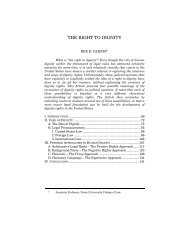A Right to Media? Lorie M. Graham - Columbia Law School
A Right to Media? Lorie M. Graham - Columbia Law School
A Right to Media? Lorie M. Graham - Columbia Law School
Create successful ePaper yourself
Turn your PDF publications into a flip-book with our unique Google optimized e-Paper software.
484 COLUMBIA HUMAN RIGHTS LAW REVIEW [41:429<br />
regional “communications societies” and Aboriginal language radio<br />
and print media. 211<br />
In the late 1970s and early 1980s Canada launched new<br />
satellite systems. 212 In connection with this technology, Aboriginal<br />
organizations began <strong>to</strong> produce original programming. The Inukshuk<br />
Project, funded and initiated by Canada’s Department of<br />
Communications, was the first <strong>to</strong> allow for the production and<br />
distribution of Inuit television. In 1981, based on the success of these<br />
projects, the CRTC licensed the Inuit Tapirisat of Canada <strong>to</strong><br />
establish an Inuit broadcasting corporation providing Inuktitutlanguage<br />
programming in the Northwest Terri<strong>to</strong>ries, Northern<br />
Quebec, and Labrador. 213<br />
Additionally, in 1983, after consultation with Aboriginal<br />
communities, three federal departments collaborated <strong>to</strong> create the<br />
Northern Broadcasting Policy and Northern Native Broadcast Access<br />
Program (NNBAP). These two initiatives were meant <strong>to</strong> ensure<br />
Aboriginal peoples “fair access <strong>to</strong> northern broadcasting distribution<br />
systems <strong>to</strong> maintain and develop their cultures and languages.” 214<br />
The NNBAP was aimed at providing long-term and stable funding <strong>to</strong><br />
broadcast organizations in Northern Canada. To this end, the<br />
government allocated forty million dollars <strong>to</strong> stimulate Aboriginal<br />
radio and television in the northern regions of Canada. Under<br />
NNBAP, First Nations organized Aboriginal “communication<br />
societies” in order <strong>to</strong> promote broadcasting in Aboriginal languages.<br />
Unfortunately, cutbacks in spending have begun <strong>to</strong><br />
undermine the work of the “communication societies” and the<br />
potential positive impact of the Broadcasting Policy. As a testament<br />
<strong>to</strong> the importance of, and demand for, indigenous media in the face of<br />
financial obstacles, the Aboriginal Peoples Television Network was<br />
launched in 1999 as the world’s first Aboriginal television network.<br />
211. The NCP helped establish over 100 radio stations, but funding for the<br />
program was terminated in 1990, resulting in the demise of many of the stations.<br />
Museum of Broadcast Communications, First Peoples’ Television Broadcasting in<br />
Canada, http://www.museum.tv/eotvsection.php?entrycode=firstpeople (last<br />
visited Feb. 5, 2010).<br />
212. <strong>Media</strong> Awareness Network, supra note 206; Jennifer David, Debwe<br />
Commc’ns Inc., Aboriginal Language Broadcasting in Canada: An overview and<br />
recommendations <strong>to</strong> the Task Force on Aboriginal Languages and Cultures 6<br />
(2004).<br />
213. <strong>Media</strong> Awareness Network, supra note 206.<br />
214. David, supra note 212, at 13.















